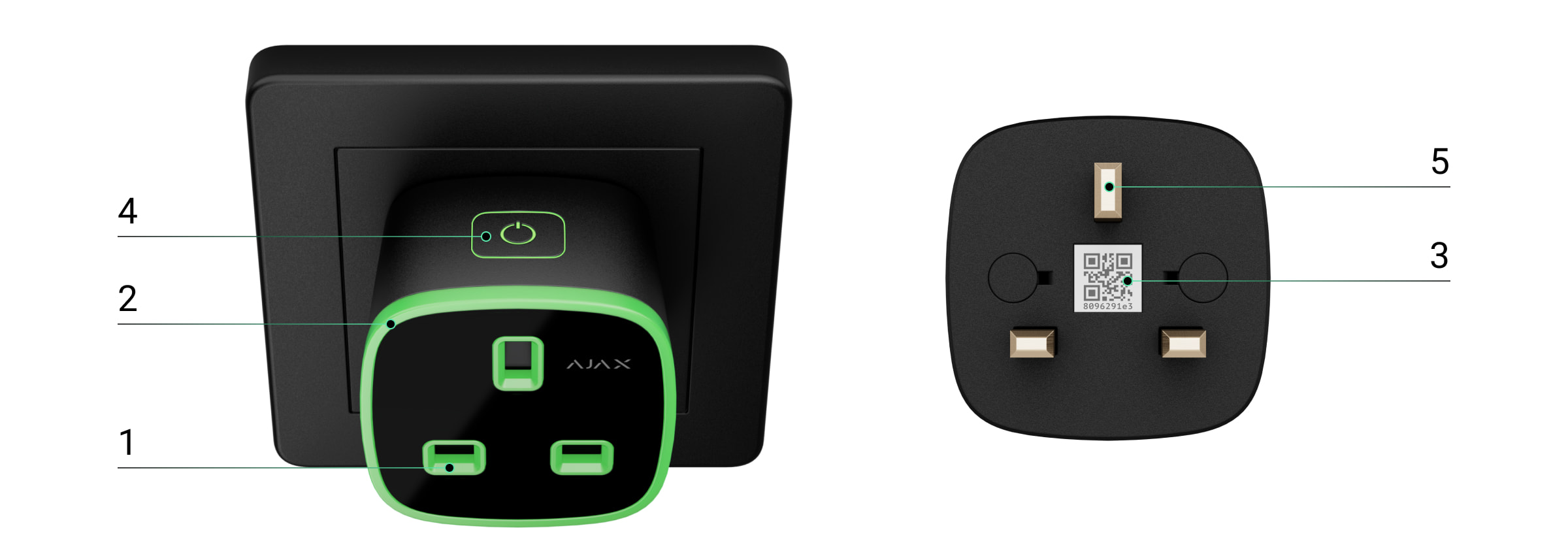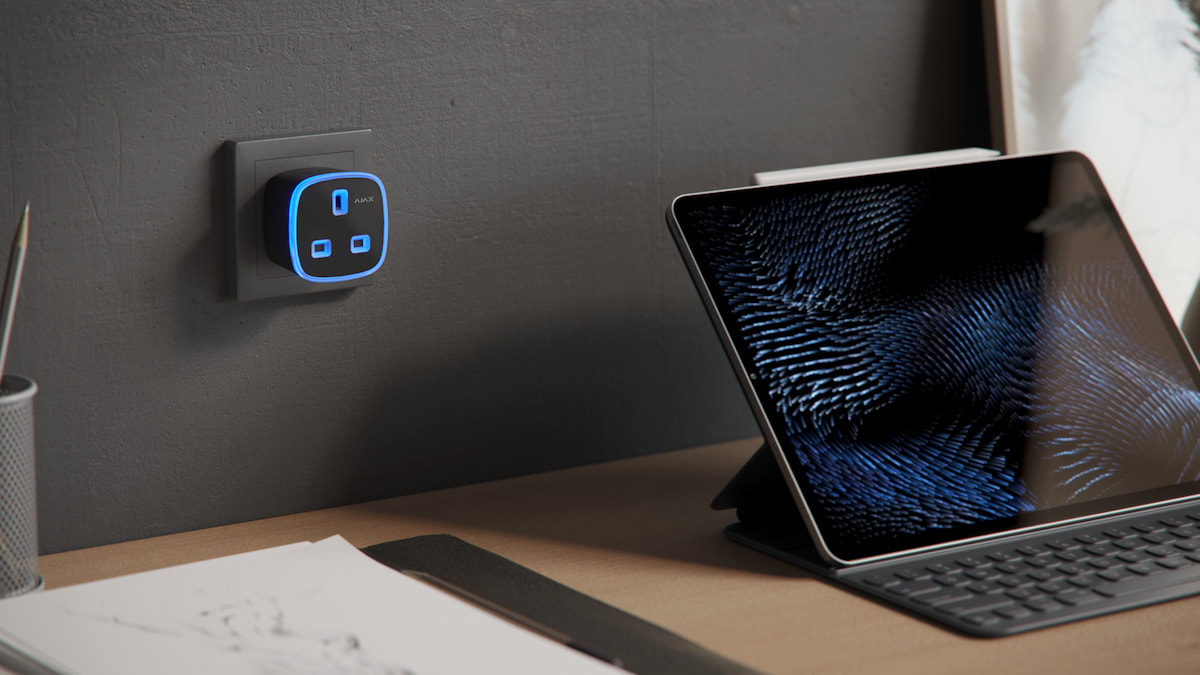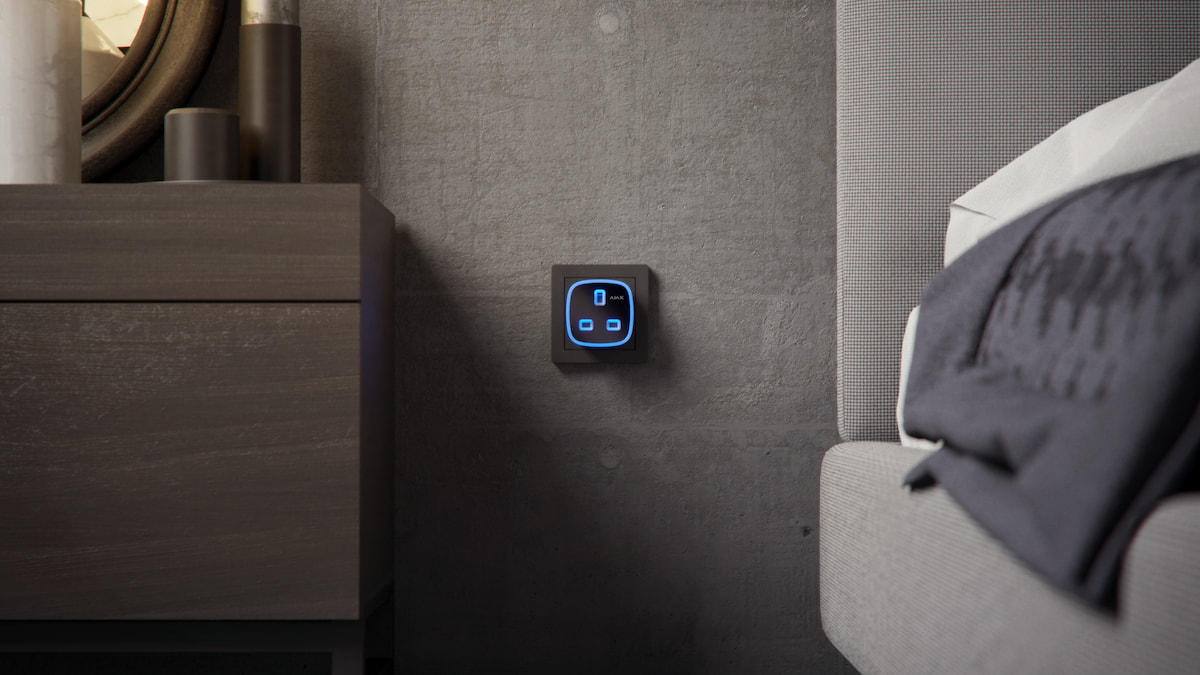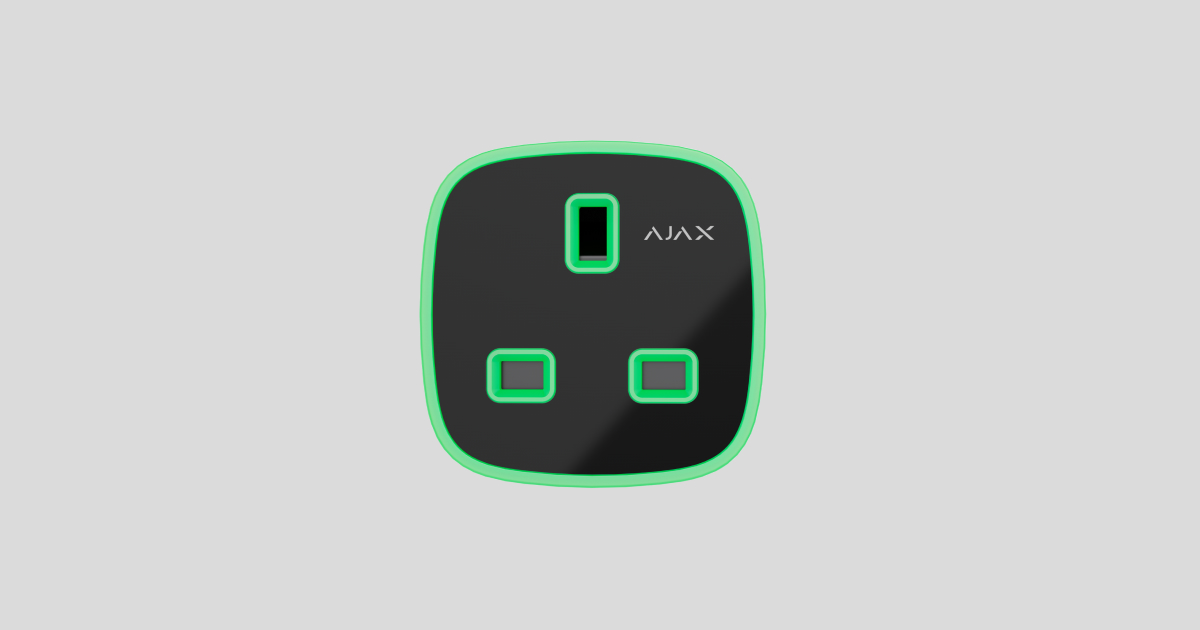Socket (type G) is a smart plug with an energy monitor. It is designed as a British-type plug adapter (type G) for indoor use. It is equipped with three types of protection: voltage, current, and temperature.
The smart plug controls the power supply of electrical appliances connected to it with a load up to 3 kW via the app, automation scenarios, functional button on the plug, and pressing Button.
Socket (type G) is connected to the Ajax system via the secure Jeweller radio protocol. The communication range is up to 1,100 meters provided if there are no obstacles.
The device works only with radio signal range extenders and Ajax hubs. Connection to uartBridge and ocBridge Plus is not provided.
Three Socket versions are available:
Functional elements

- Three-pin socket (type G).
- LED border. Uses colour to indicate the Socket (type G) state and the current load level.
- QR code. It is used to add the plug to the system.
- Functional button.
- Three-pin plug (type G).
Operating principle
Socket (type G) is an Ajax system smart plug. It controls the power supply to the connected devices by opening one of the poles. The plug can be managed by pressing the functional button, via a command from the Ajax app, by pressing the Button, or via scenarios.
Socket (type G) can operate in both pulse and bistable modes. When Socket (type G) is working in the pulse mode, its duration can be set from 1 to 255 seconds. A user with administrator rights or a PRO specifies the operating mode in the Ajax apps.
A user or a PRO with administrator rights can select the normal state of the plug contacts:
- Normally closed (NC) — the plug stops supplying power when activated and resumes when deactivated.
- Normally open (NO) — the plug supplies power when activated and stops when deactivated.
Socket (type G) measures the connected electrical appliances’ current, voltage, power, and power consumption. This data, as well as other plug operating parameters, is available in the States section in the Ajax apps. The updating rate of the plug statuses depends on the Jeweller settings. The default value is 36 seconds.
The maximum resistive load of the plug is 3 kW (with 13 A current protection installed). If an inductive or capacitive load is connected, the maximum switching current drops to 8 A.
Automation scenarios
Ajax’s scenarios offer a brand-new level of property protection. With scenarios, the security system not only notifies about a threat but also actively resists it.
Use scenarios to automate security, for example, by setting the lights, TV, and audio system in a private house to turn on by schedule. That way, a house won’t seem empty and attract the attention of burglars while users will be on vacation.
Socket (type G) supports the following scenario types:
- Alarm reactions. For example, switching on the light if the DoorProtect raises the alarm.
- Security mode change reactions. For example, turning off the iron when the security mode is on.
- Scheduled actions. For example, switching the heater on at 7:00 PM and turning it off at 9:00 PM.
- Upon pressing Button. For example, turning on the night light by pressing Button.
- By temperature. For example, switching the air conditioning when the room temperature is above 25°C.
- By CO2 concentration. For example, turning on the supply ventilation when the carbon dioxide concentration increases.
- By pressing LightSwitch. For example, turning off all electrical appliances when the light is turned off.
Moisture and CO2 scenarios are available ifLifeQuality is added to the system.
If the device is offline, it will not execute the scenario as it misses the scenario trigger (e.g., during a power outage or when the connection between the hub and device is lost).
Use case: The automated action is scheduled for 10 a.m., so it must start at 10 a.m. The electrical power goes out at 9:55 a.m. and is restored ten minutes later. The automation scenario won’t start at 10 a.m. and will not start immediately after the power is back on. This scheduled action is missed.
Control via the app
Users can manually control switching on and off electrical appliances connected via Socket (type G) in the Ajax app.
To do this, a user needs to press the toggle in the plug field in the Devices menu of the Ajax app. After this, the state of the plug contacts will be reversed, and the connected appliance will be turned off or on. This way, users can remotely control the power supply, for example, of a heater or a humidifier.
Socket (type G) protection types
Socket (type G) has three types of protection that work independently: voltage, current, and temperature protection.
Voltage protection: activates when the plug voltage exceeds 184–253 V~. It protects connected devices from voltage surges. We recommend deactivating this protection if the Socket G is connected to 110 V~ mains.
Current protection: activates when the load current exceeds the limits set in the Ajax app. It protects connected appliances and the smart plug from overcurrent. The current limit is set from 1 to 16 A in increments 1 A in the Socket (type G) settings. The default value is 13 A.
For regular loads, we recommend using current values up to 13 A. Values between 13 and 16 A can only be used for short-term loads.
Temperature protection: activates when the smart plug heats up above 95℃. Protects the smart plug from overheating.
Socket (type G) stops the power supply if the voltage or temperature protection activates. The power supply resumes automatically when voltage or temperature returns to normal. The power supply won’t be restored automatically if the current protection activates. This can be done by a command in the Ajax app or by pressing the functional button.
Energy consumption monitoring
In the Ajax app, the following energy consumption parameters are available for appliances connected via a smart plug:
- Voltage.
- Load current.
- Power consumption.
- Power consumed.
The frequency of parameters update depends on the Jeweller polling period (the default value is 36 seconds). The power consumption values are displayed in increments of 1 W.
You can reset the power consumption values in the plug settings:
- Go to the Devices
tab.
- Select Socket (type G) in the list.
- Go to Settings by clicking on the gear icon
.
- Click Reset Energy Consumption Meter.
- In the pop-up window, click Reset.
- Click Back to save the new settings.
After resetting, the date of the last reset will be displayed in the States of the plug.
Functional button
The functional button controls the power supply to the connected electrical appliances without the app, scenarios, or Button. The operation algorithm depends on the smart plug mode: pulse or bistable.
When Socket (type G) operates in the bistable mode, pressing the functional button reverses the state of the plug contacts. For example, if the contacts are closed (plug supplies power), they will open (plug doesn’t supply power) after pressing the button.
When Socket (type G) operates in the pulse mode, pressing the functional button closes or opens the contacts (depending on the normal state of the plug) for the time set in the settings. Pressing the functional button again will interrupt the command, and the plug will close or open the contacts (depending on the normal state of the plug) until the end of the pulse.
Jeweller data transfer protocol
The smart plug uses the Jeweller radio protocol to transmit alarms and events. This two-way wireless data transfer protocol provides fast and reliable communication between the hub and the system devices.
Jeweller supports block encryption with a floating key and authentication of devices at each communication session to prevent sabotage and device spoofing. The protocol involves regular polling of detectors by the hub at intervals of 12 to 300 seconds (set in the Ajax app) to monitor communication with all devices and display their statuses in the Ajax apps.
Sending events to the monitoring station
The Ajax system can transmit alarms and events to the PRO Desktop monitoring app as well as the central monitoring station (CMS) as a SurGard (Contact ID), SIA (DC-09), ADEMCO 685, and other proprietary protocols. A complete list of supported protocols is available here.
Only events of lost connection between the hub or range extender and Socket (type G) are transmitted to the CMS. PRO Desktop can be used to receive all smart plug events at the CMS.
Address capacity of Ajax devices allows sending to PRO Desktop/CMS events and the type of the device, its assigned name, and room. The list of transmitted parameters may vary depending on the CMS and the selected communication protocol.
The device ID, loop (zone) number, and bus number can be found in device States in the Ajax app.
Connection
Before device connection
- Install the Ajax app. Log in to your account or create a new if you don’t have one.
- Add a plug-compatible hub to the app, set the necessary settings, and create at least one virtual room.
- Ensure that the hub is turned on and has Internet access via Ethernet / mobile network. You can do this in the Ajax app or by looking at the hub LED. It should light up white or green.
- Ensure the hub is not armed and does not start updates by checking its status in the Ajax app.
Only a user or a PRO with administrator rights can connect a smart plug to the hub.
To connect Socket (type G) to a hub
- Plug in Socket (type G) if you haven’t done this before.
- Sign in to the Ajax app.
- Select a hub if you have several of them or using the PRO app.
- Go to the Devices
menu and click Add device.
- Name the device, select a room, scan the QR code (located on the plug’s body and its package) or type the device ID.
- Press Add — a countdown will start.
- After a few seconds, Socket (type G) will appear in the hub device list.
To connect Socket (type G), it must be within the range of the hub radio network. If the maximum number of devices is added to the hub, you will get a notification about exceeding the device limit in the Ajax app when you try to add Socket (type G). The maximum number of devices connected to the hub depends on the central unit model.
If the connection fails, turn off the plug and try again in 5 seconds. This time, press and hold the functional button on the plug for at least 2 seconds during the countdown.
Socket (type G) only works with one hub. When connected to a new hub, it stops sending notifications to the old one. Once added to a new hub, Socket (type G) is not removed from the list of devices of the old hub. This has to be done in the Ajax app.
If you connect a previously connected plug to another hub, make sure it is removed from the previous hub. For a device to be removed correctly, it must be within the range of the hub radio network at the time of removal. After removing Socket (type G), its LED frame will flash green once per second.
Malfunction counter
In case of the Socket (type G) malfunction (e.g., no Jeweller signal between the hub and the plug), the Ajax app displays a malfunction counter in the upper left corner of the device icon.
All malfunctions can be seen in the smart plug States. Malfunction fields will be highlighted in red.
A malfunction is displayed if:
- Current protection is activated.
- Temperature protection is activated.
- Voltage protection is activated.
- There is no connection between the hub/range extender and Socket (type G).
Icons
The icons show some of the Socket (type G) states. You can view them in the Ajax app on the Devices tab.
| Icon | Meaning |
| Jeweller signal strength — displays the signal strength between the hub and the smart plug. | |
| The device is connected via a radio signal range extender. | |
| Current protection is activated. | |
| Voltage protection is activated. | |
| Temperature protection is activated. | |
| The device has lost connection with the hub or the hub has lost connection with the Ajax Cloud server. | |
|
The device has not been transferred to the new hub. |
States
The states include information about the device and its operating parameters. Socket (type G) states are available in the Ajax app. To access them:
- Go to the Devices
tab.
- Select Socket (type G) in the list.
| Parameter | Meaning |
| Data import | Displays the error when transferring data to the new hub:
|
| Malfunction |
Clicking on The field is displayed if a smart plug malfunction is detected. |
| Jeweller Signal Strength |
Jeweller is a protocol for the transmission of events and alarms. The field displays the Jeweller signal strength between a hub or a range extender and Socket (type G). Recommended values: 2–3 bars. |
| Connection via Jeweller | Connection status between a hub or a range extender and a smart plug:
|
| Active | The smart plug state:
The field is displayed if Socket (type G) operates in the bistable mode. |
| ReX | Displays the connection status of the plug to the radio signal range extender:
The field is displayed if the plug is operated via the radio signal range extender. |
| Current |
The value of current commuted by Socket (type G). The frequency of value updates depends on the Jeweller settings. The default value is 36 seconds. Values of current are displayed in increments of 10 mA. |
| Voltage |
The value of voltage commuted by Socket (type G). The frequency of value updates depends on the Jeweller settings. The default value is 36 seconds. Values of voltage are displayed in increments of 1 V AC. |
| Current Protection Threshold |
Current protection — the power supply is switched off if the current exceeds the figure adjusted in the app. The current limit is adjusted in the range from 1 to 16 A in increments of 1 A. For regular loads, we recommend using current values up to 13 A. Values between 13 and 16 A can only be used for short-term loads. |
| Voltage Рrotection | Voltage protection state:
The smart plug will automatically continue to operate when the voltage returns to normal. We recommend deactivating this protection if the Socket G is connected to 110 V~ mains. |
| Power |
The power consumption of an appliance connected to the smart plug. The frequency of value updates depends on the Jeweller settings. The default value is 36 seconds. The power consumption values are displayed in increments of 1 W. |
| Electric Energy Consumed |
The energy consumed by a device connected to the smart plug. If power consumed values are reset, the field displays the last reset date. The frequency of value updates depends on the Jeweller settings. The default value is 36 seconds. The power consumed values are displayed in increments of 1 W. The counter can be reset in the device Settings. The app remembers the last value and displays it when power is lost. |
| Permanent Deactivation | Shows the state of the device permanent deactivation function:
|
| Firmware | Smart plug firmware version. |
| Device ID | Device ID/serial number. It can be found on the plug box and its body. |
| Device No. | The number of the smart socket loop (zone). |
Settings
To change the smart plug settings in the Ajax app:
- Go to the Devices
tab.
- Select Socket (type G) in the list.
- Go to Settings by clicking on the gear icon
.
- Set the required parameters.
- Click Back to save the new settings.
| Setting | Meaning |
| Name |
Socket (type G) name. It is displayed in SMS and notifications in the event feed. Click on the pencil icon The name can contain 12 Cyrillic characters or up to 24 Latin characters. |
| Room |
Selection of Socket (type G) virtual room. The room name is displayed in SMS and notifications in the event feed. |
| Notifications | Selecting the plug notifications:
The setting is available when Socket (type G) is connected to all hubs (except for the Hub model) with firmware version OS Malevich 2.15 or higher and in apps of the following versions or higher:
|
| Current Protection Threshold |
Maximum current commuted by Socket (type G). The current limit value is set from 1 to 16 A in increments of 1 A. Default value: 13 A. If this value is exceeded, the current protection activates, and the smart plug stops supplying power to the connected electrical appliance. Power can be restored manually in the Ajax app or by pressing the functional button on the plug. |
| Voltage protection |
When this option is active, the power of the appliance connected to the plug will be cut off if voltage exceeds 184–253 V~. We recommend deactivating this protection if the Socket G is connected to 110 V~ mains. |
| Indication | Selection of the LED frame state:
|
| LED Brightness | The brightness level of the LED frame of the smart plug is adjusted with a scrollbar. |
| Mode | Selection of the operating mode of the plug:
|
| Contact State | Selection of the normal state of the plug contacts:
|
| Pulse Duration, sec |
Selection of the pulse duration: 1 to 255 seconds. The setting is available when Socket (type G) operates in the pulse mode. |
| Reset Energy Consumption Meter | Resets the power consumption data |
| Scenarios |
Opens the menu for creating and configuring automation scenarios. Scenarios offer a brand-new level of property protection. With them, the security system not only notifies about a threat but also actively resists it. Use scenarios to automate security. For example, switch on lighting in the facility when an opening detector raises an alarm. |
| Jeweller Signal Strength Test |
Starts Jeweller signal strength test for Socket (type G). The test allows checking the Jeweller signal strength and the stability of the connection between a hub or a range extender and a smart plug to choose the best place for installing the device. |
| User Guide | Opens Socket (type G) user manual in the Ajax app. |
| Permanent Deactivation |
Allows disable the device without removing it from the system. Two options are available:
After deactivation, Socket (type G) will keep the previous state: active or inactive. |
| Unpair device | Disconnects the device from the hub and deletes its settings. |
Indication
Socket (type G) informs about its state and the power consumption of the connected devices with the LED frame indication. The power consumption value is available in the plug States in the Ajax app.
| Load level | Indication |
| No power supply | No light |
| Socket (type G) is off | Lights up blue |
| Socket (type G) is on, load from 0 to 549 W is connected | Lights up green |
| From 550 to 1249 W | Lights up yellow |
| From 1250 to 1999 W | Lights up orange |
| From 2000 to 2839 W | Lights up red |
| From 2840 to 3679 W | Lights up dark red |
| 3680 W and above | Lights up purple |
| One or more types of protection (e.g., current and/or voltage) are activated | Slowly lights up red and turns off |
Functionality testing
Socket (type G) functionality tests do not begin immediately, but not later than over a single hub – smart plug polling period (36 seconds with the Jeweller standard settings). You can change the ping period of devices in the Jeweller menu of the hub settings.
To run a test, in the Ajax app:
- Select a hub if you have several or use a PRO app.
- Go to the Devices
tab.
- Select Socket (type G) in the list.
- Go to Settings
.
- Select and run the Jeweller Signal Strength Test.
Selection of the installation site

When choosing where to install Socket (type G), take into account the Jeweller signal strength and the distance between the device and the hub or the presence of objects that obstruct the radio signal: walls, inter-floor slabs or large structures located at the premises.
Socket (type G) must be installed with a stable Jeweller signal level of 2 to 3 bars.
To roughly calculate the signal strength at the place of installation, use our radio communication range calculator. Use a radio signal range extender if the signal strength is less than 2 bars at the intended installation location.
Do not place Socket (type G):
- Outdoors. Doing so may cause the device to malfunction or not work correctly.
- Near metal objects or mirrors (e.g., in a metal cabinet). They can shield and attenuate the radio signal.
- Inside any premises with the temperature and humidity beyond permissible limits. Doing so may cause the device to malfunction or not work correctly.
- Close to radio interference sources: less than 1 meter away from the router and power cables. This can cause a loss of connection between a hub or a range extender and the smart plug.
- In places with low or unstable signal strength. This can cause a loss of connection between a hub or a range extender and the smart plug.
Installation

Before installing the smart plug, make sure that you have selected the optimal location and that it complies with the requirements of this manual.
When installing and operating the device, follow the general electrical safety rules for using electrical appliances and the requirements of electrical safety regulations.
To install Socket (type G):
- Select the plug into which you want to install the Socket (type G).
- Plug the Socket (type G) in.
Socket (type G) will turn on within 3 seconds after connection. The device indication will inform you that it is on.
Maintenance
The device requires no maintenance.
Technical specifications
Complete set
- Socket (type G).
- Quick start guide.
Warranty
Warranty for the Limited Liability Company “Ajax Systems Manufacturing” products is valid for 2 years after the purchase.
If the device does not function correctly, please contact the Ajax Technical Support first. In most cases, technical issues can be resolved remotely.
Contact Technical Support:



